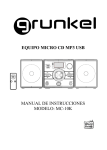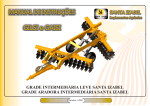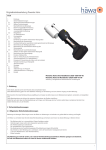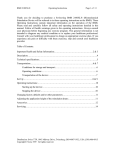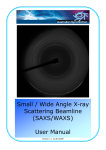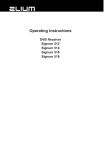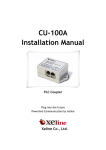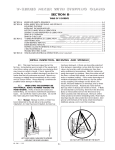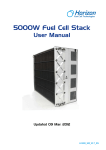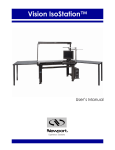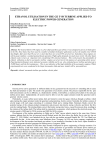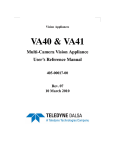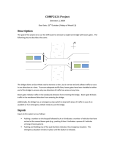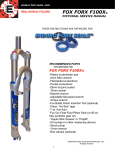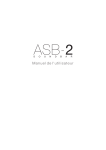Download Mayday Manual - APCO Aviation
Transcript
APCO AVIATION USER MANUAL Mayday INDEX Introduction Disclaimer & Warranty Description Specifications Maintenance Packing Preliminary Notes Tools and Equipment Airing, Layout and Folding Fitting to Deployment Bag Deployment Using your Mayday Introduction Even pilots flying the safest paragliders or hang gliders, can sometimes find themselves with their glider damaged, disabled or tangled and out of control. In such cases a reliable emergency system with a fast opening parachute can make the difference between a simple scare and a fatal accident. Your emergency system has been designed for a fast opening at a low air speed. Do not, under any circumstances use this emergency system for free fall parachuting. APCO is happy and proud that its emergency systems, developed and perfected over nearly three decades have saved the lives of many pilots, from beginners to world champions. This manual describes 6 such emergency systems: three for paragliding and three for hang gliding. WARNING Your emergency system has been designed for a fast opening at a low air speed. Do not, under any circumstances use this emergency system for free fall parachuting. Disclaimer of Liability and Warranty In designing and manufacturing the Mayday parachutes and any of its subassemblies or accessories, our aim has been to create a rescue system that will allow the user to engage in the sport of paragliding or hang gliding in a safe and confident way. However, both paragliding and hang gliding are high risk activitie, which may cause or result in serious injury or death. When you take it upon yourself to participate in one or both of these sports, you accept the risk inherent therein. You may reduce the risk by receiving proper instruction and by following the basic safety requirements. The Mayday Reserve Parachute System is a sensitive device, which may easily be damaged. Before each flight, the container should carefully be inspected for evidence of damage or wear and propper closure. Any deviation from the manufacturers specifications concerning maintenance, repair, alterations and modifications constitutes willful negligence. It is expressly understood and agreed that by the use hereof by the buyer or any subsequent user that Apco Aviation Ltd. And/or the seller shall in no way be deemed or held liable or accountable and makes no warranty, either expressed or implied, statutory, by operation of law or otherwise, beyond that expressed herein. Paragliding and Hang gliding equipment is sold with all faults and without any warranty of merchantability or fitness for any purpose, expressed or implied. Apco Aviation Ltd. 1 of 16 Disclaims any liability in tort for damages, direct or consequential, including personal injuries, resulting from a malfunction or from a defect in design, manufacturing, materials or workmanship, whether caused by negligence on the part of Apco Aviation Ltd. or otherwise. By using any Paragliding or Hang gliding equipment manufactured or sold by Apco Aviation Ltd., or allowing it to be used by others, the buyer and/or user waives any liability on the part of Apco Aviation Ltd., for personal injuries or any other damages arising from such use. The liability of Apco Aviation Ltd. is limited to the replacement of defective parts found under examination by manufacturer to be defective in material or workmanship within 120 days after purchase, and which has not been caused by an accident, striking, improper use, alteration, tampering, excessive use, misuse or abuse. The damages of the buyer and/or user shall be deemed liquidated in the costs of replacement as above. Description The Apco Mayday series of parachutes are flat circular pull-down apex reserves. This means that in addition to the conventional lines around the perimiter (skirt), there is a single line in the center pulling the apex down to the level of the skirt running from the apex to the bridle. The main line attachments to the skirt are reiforced with V-Tabs, and the skirt and apex skirt are reinforced with 1'tape, and sewn with a four needle machine for an exact finish. This proven design offers the best combination of sink-rate, deployment speed, packing size and weight. Specifications Mayday 16 18 20 Bi 25m2 30m2 37m2 47m2 16 18 20 18 Line Length 4700mm 5150mm 6720mm 5875mm Center Line Length 4700mm 5150mm 7300mm 6310mm Weight 1.863kg 2.220kg 2.690kg 3.250kg Sink Rate 6.1 m/s 5.4 m/s 5.4 m/s 5.4 m/s Max Load Up to 106kg 75 - 120kg 100 - 160kg 120 - 200kg DHV SHV AFNOR/CEN AFNOR/CEN Area Gores Certification Maintainance The materials we use to manufacture the Mayday range of parachutes are carefully selected from the best mil. spec. products available on the market today. These materials are however sensitive to sunlight (UV). The container or harness will protect the canopy from ultra-violet rays. When storing the parachute it should be kept in a cool dry place. Beware of mildew. Should your parachute be exposed to any moisture, it must be opened and air dried, out of direct sunlight, and repacked when completely dry. Cleaning If your parachute requires cleaning, it should be soaked in luke warm water with a little mild soap. No rubbing or scrubing of the canopy fabric! It should then be thoroughly and repeatedly rinsed with fresh water and allowed to drip dry out of direct sunlight. Repairs Should your Mayday parachute require any repairs or you suspect it may be damaged, it must be refered back to APCO Aviation Ltd. or a professional parachute loft, with a certified parachute rigger to carry-out the repair. Periodical Repacks Even though the Mayday Emergency System should remain in good condition and work 2 of 16 properly over a number of years, we strongly reccomend that the parachute be repacked by a qualified person once every six months. Packing by a unqualified person is undertaken at the pilots own risk, and is not recomended by Apco. Identification In the corner where the #1 suspension line meets the skirt, there is an Apco stamp, along with the individual serial number, canopy type and manufacture date. This data is repeated on a label attached to the bridle in post 1995/6 models. In any correspondence to apco regarding your Mayday, please quote this information. Attachment Procedure There are many different harnesses on the market today, with several diffetent reserve stowing systems. Make sure your harness is certified and has a adequate instruction manual. For attaching and fitting your reserve to your harness follow your harness manual instructions carefully. Prelimanary Notes on Packing The following Instructions apply to ALL models of the Mayday Range, unless otherwise stated. When first delivered, your new emergency parachute system has been inspected and packed by Apco or an Apco approved dealer and is ready for use. The following set of folding instructions is intended for a qualified packer familiar with conventional parachute packing, to guide him/her in packing of these particular types of parachutes. The Modularity of Apco Emergency Systems Although the above specifications list eight separate types, with slightly different innier and or outer containers, the "heart" of the system, the parachute and its bridle, are only a combination of four different parachutes, and three different types of bridles: Parachute The smallest, MD16 parachute, for a maximum hook-in weight (pilot, glider, harness, and emergency system) of 106kg; the MD20 for a maximum hook-in weight of 120kg; the MD20 for up to 180kg and the MD Bi Tandem parachute for a maximum of 220kg. Bridle Short: About 30cm in length, for solo paragliding systems, because of the short distance between the packed parachute, and its attachment point to the harness (the parachute is designed to open slightly below the paragliding canopy). Long: About 6 meters in length, for all hang glider systems, due to the need of clearing the glider frame on opening. V-Bridle: For Tandem Paragliding systems. This brildle is attached to the top of the spreader system, sothat both pilot and passenger is suspended at a equal height. Tools and Equipment Table Although the Maday can be folden on the ground, provided it is smooth and clean, the best arrangement is to use a long table, or several tables placed end to end, with a smooth surface, 8m long, 1m wide and about 80 cm high. At each end of the table there should be a hook-up point for attaching and tentioning the reserve. Woodwork clamps work well. 3 of 16 Comb This is a wooden board with a row of two groups of 11 nails each, which serves to keep the lines separated and in correct order during folding. The nails protrude about 20mm above the board. The central gap between the two groups of nails is 20mm. The general nail spacing is 10mm. The board measures approximately 30cm long, 7-10cm wide and around 20mm thick. The board and the nails should be smooth, without any sharp corners or edges that may damage the parachute or lines. Clamps or weights Six lightly spring-loaded clamps, such as paper clamps are ideal. It is also possible to use weights, such as small sandbags, solid weights or even books. Whichever you use, they should have smooth edges and no sharp corners. Carabiners It is usefull but not essential to have two carabiners for attaching the apex and lines to the table hook-up points. Some string such as glider lines will also do. Tie-down Straps (2) This is also usefull but not necesarry, it is used to tension the lines. Some rope or line will suffice. Airing, Layout and Folding 4 of 16 Airing Before starting the repack procedures it is recomended to "air" the canopy for 24 hours. This is best done by suspending the canopy from its apex, from a point on the ceiling. This should be done in a cool dry place out of direct sunlight. Layout Lay the extended canopy on the table as shown. Attach a carabiner through all the apex lines and through the loop of the center apex line (the one that leads to the bridle). clip this carabiner to the hook-up point on one side of the table. One of the gores bears an Apco tag in a lower corner, next to the attatchment point of a line. This is the No.1 line. The first and Last lines (No.1 and 16, 18 or 20) are numbered in this way on all parachutes. The remaining lines (no.2 and up) may or may not be numbered depending on the year of manufacture. If they are not numbered, count them in a counter-clockwise fasion, (When standing near the skrit looking toward the apex, starting at the bottom). Apex Hook-up Detail The Apex should be clipped or tied through all the apex cross-over lines AND the Apex center line (which runs down inside the canopy to the Bridle). Suspension Line Hook-up Clip another carabiner around all the suspension lines except the central line, as shown and attach it with two tie-down straps, to the second hook-up point on the opposite end of the table from the apex. Apply some tension until all the lines are straight. The Bridle Position The bridle should now be somewhere in between the skirt and the carabiner attached to the suspension lines. 5 of 16 Comb Placement Place the comb under the lines near the skirt of the canopy. The purpose of the comb is to ensure that all the lines run parallel to each other all the way from the skirt to the bridle, without crossing, twisting or tangling. Place the Center Line in the wider gap in the center of the comb. Line placement into the Comb Place line No.1 in the first gap imiediatly to the right of the Center Line, then Line No.2 immiediatly right of line No.1. and continue in this fasion until half of the lines are used. It is important to ensure that you use the lines in the correct order. The easyest way to do this is to flip the gores over onto the left hand side. The amount will be 8 for the Mayday 16, 9 for the Mayday 18, 10 for the Mayday 20 and 9 for the Mayday Bi. Now use a strong elastic to secure these lines in place including the center line, by hooking the elastic over the first and last nails in the group. Flip all the gores over to the right hand side and start with the lines on the left hand side in a similar fasion the the right. Place the last line (No.16, 18 or 20), in the gap immiediatly left of the Center Line, then follow it with the line before last, and so on until you have an equal number of lines on either side of the comb. Secure the lines with a second strong elastic band or hair elastic. Move Comb Move the comb approximately one meter down the lines away from the skirt. Flip the left hand-group of gores over the right-hand group again. Paging the Left Flip the left hand-group of gores over the right-hand group. Bring the flipped gores back one by one, lifting them with one hand by the point halfway between the two line attachment points, while holding all the lines down together on the table with the other hand. Make sure to lift the complete gore up by applying a little tension with the lifting hand against the apex. While doing this carefully inspect each panel on both sides for wear, damage, stains, deterioration, mildew, etc. 6 of 16 Stacking the Left Neatly place each panel down on top of each other, making sure that the folds halfway between the two hook-up points are all lining up at the corner formed by the gores on the left. Also take time to neatly align all the skirt webbing, one fold on top of the next. Do not take more than half of the gores!. Use some paper clamps, or weights to keep the folded gores in place. Corner fold-over - Left Make a fold halfway along the left-hand base at 45o and clamp it in place. Paging the Right Flip all the right hand gores across onto the left. Now repeat the above paging steps for the right-hand side. Remember to clamp or hold all the lines together at the hook-up points. Corner fold-over - Right Lift the uppermost gore from the right hand side and then make the 45o corner in a similar fasion as done on the left (exclude the uppermost gore from the fold-over). Clamp the fold in place. Gore count The number of gores on each side should now be as follows, with one in the middle on top. Mayday 16: 8 gores on the left and 7 gores on the right. Mayday 18: 9 gores on the left and 8 gores on the right. Mayday 20: 10 gores on the left and 9 on the right. Mayday Bi: 9 gores on the left and 8 gores on the right. 7 of 16 Clamp Place two attitional clamps just less than halfway along the folded canopy. Making sure that all the folds are even on both sides. Tension Release Release the tension at the top and unclip both the carabiners, on the lines near the bridle and the Apex fastening carabiner. Apex Insertion By hand, gently insert the apex into the top of the canopy, between the gores, as far as you can reach. Apex Insertion Apex Insertion Pulling down the Apex Take the bridle and slowly pull it away from the skirt, so as to tension all the lines. Have a assistant do this while you ensure that the top end folds neatly as the apex is pulled down into the canopy. All the lines, including the Center/Apex Line should now be straight and of a equal length. 8 of 16 Apex Position The Apex lines should not be pulled any further than the skirt. On some sizes the apex will not reach the skirt at all. Make sure that all the lines including the apex line are now equalized withe the bridle fully extended away from the canopy. Combing Hook the bridle to the clamp at the end of the table and tension the lines (move the canopy if nesesary) Move the comb all the way towards the bridle, "combing" the lines all the way up to their attachment points on the bridle. IT IS OF UTMOST IMPORTANCE THAT THE LINES SHOULD RUN STRAIGHT AND PARALLEL TO ONE ANOTHER ALL THE WAY FROM THE CANOPY SKIRT TO THE BRIDLE, WITHOUT ANY CROSSING OR TWISTING, AND THAT THE BRIDLE SHOULD LAY SO THAT THEY JOIN IT SIDE BY SIDE. THE BRIDLE SHOULD NOT BE TURNED OR TWISTED IN THE SUBSEQUENT STAGES OF FOLDING. Any twists or tangles can be undone by manipulating the bridle in the correct direction. If not, you have laid some of the panels incorrectly and you will have to start over. Remove Comb Remove the comb and pull the ripstop line attatchment cover over the lines after inspecting each attatchment carefully. Make sure there is no wear or unraveling of stitching. 9 of 16 Shape This is what the partly folded canopy should now look like. Top Fold Remove the top clamps and make a fold on each corner as shown and then replace the clamps to hold the folds. Continue both the folds along the length of the canopy by folding over the bottom corners (45o corners) to achieve a rectangular shape as shown in the next photo. Center Gore Pull out the Center gore just a little, from under the folds and flatten it in its place. It should now be covering the start of the folds on either side as shown. Top Fold Fold the top of the reserve in half. Remove the clamps and replace one to hold the new fold in place. Now pull the "opening"/Skirt of the center gore out to the left as shown. 10 of 16 Folding Fold the right hand side of the bottom section onto the left. Place one of the free clamps halfway along the pack. Check opening Make sure that the opening/skirt of the central gore is neatly in place, and lying along the bottom edge and continues up the side between the layers formed by the left and right hand sides. Opening Detail Deployment container/Nappy Sizing Place the deployment container/nappy next to the reserve. Make sure that the side with the bungee is facing up and that the bungee is pointing to the side the lines leave the pack as shown. Fold the "pack" in a Zigzag pattern so as to form a square that will fit in the center part of the Deployment container. Zigzag Folding 11 of 16 Zigzag Folding Lift the pack onto the deployment container. Zigzag Folding Zigzag Detail Closing (Step 1) Closing (Step 1) Lift flap No.1 (Opposite side of the Bungee) and thread a loop from the center of the bungee through the grommet in the flap. Closing (Step2) Lift flap No.2 (on the left) and thread the bungee loop through the grommet in the flap. Closing (Step 3) Lift flap No.3 (on the right) and thread the bungee loop through the grommet in the flap. Now pass a loop of the suspension lines through the bungee loop to lock the three flaps in place.The loop of lines should protrude only about 5-6cm through the bungee. An additional check of the bungee: the loop of the lines should begin to slip out under a force of not more than 200grams. Line Stacking (Step 1) Line Stacking (Step 1) Take four light latex-rubber bands and inspect them for cracks, wear, and fatigue. It is best to use special parachute grade elastics obtainable from Apco, or your Apco dealer. If, however, you must use simple office rubber bands, they must be approximately 4cm in diameter, with a square section of 1-1.5mm, fresh and of good quality and of uniform cross-section. Attach two elastics to each side of the bungee cord, approximately 3cm appart, and 3cm away from the end (attachment point to the deployment bag) of the cord. 12 of 16 Begin to fold the lines into a zig-zag of a width equal to the width of the folded canopy package. It is easiest to do this properly by folding them into flattened figure-eights, on top of one another. Line Stacking (Step 2) After using just less than half the tolat line length, stop and insert the "stack into the lower set of elastics attached to the bungee. Line Stacking (Step 3) The right hand elastic should be to the left of the lines leading from the skirt to the first closing loop, but to the right of where the lines lead from the first closing loop to the line "stack". Line Stacking (Step 4) Now make a second "stack" of lines in a simalar fasion to the first, using all but the last 60-70cm of suspension lines. Line Stacking (Step 5) Place this "stack" in the upper set of elastics. The right hand elastic should be to the right of the lines leading from the skirt to the first closing loop. Line Stacking (Step 6) 13 of 16 Line Stacking (Step 7) Line Stacking (Step 8) Make sure that all the lines are arranged neatly with out twists, line-overs, etc. Line Stacking (Step 9) Now fold the remaining section of the suspension lines across the "pack". Second Closing Loop Fold the fourth flap of the container over the stacked lines. Lift the bungee on top of the first closing loop and pass the loop through the grommet on the flap. Second Closing Loop Lock the last flap in place with a loop of the suspension lines to make the second closing loop. Second Closing Loop 14 of 16 Second Closing Loop Second Closing Loop Pass the closing loop through the webbing loop on the last flap to keep it clear of the loop of the first closing loop. The packed Parachute Test Test the force required for the closing loop to slip through the bungee. There are two methods to do this. Hook a spring balance to a loop in the remaining part of the suspension lines and hold the bridle down next to the container. Slowly lift the scale until the lines start to slip through the bungee and take the reading of the scale at this point. The force required using this method should not exceed 400 grams. Test Using the second (direct) method one hooks the scale directly to the bridle. The force should not exceed 200 grams with this method. 15 of 16 Using Your Mayday It is ofcourse best if you never have to use it, but even then, flying with an energency system provides peace of mind and a feeling of security, which make your flights even more enjoyable. Some paragliding and Hang-gliding schools and clubs offer courses in the use of emergency systems, and it is recommended to take such a course. The openings are carried out over water and the pilot wears a flotation vest. Once in the water a boat picks them and the equipment out. Such a course provides valuable experience, and adds confidence in your emergency system. OPENING YOUR EMERGENCY PARACHUTE The first step in opening your emergency parachute is the decision to do so. If you have lost control of your aircraft at a considerable height and there is a chance of regaining it, you still have time to try. Once you have opened your emergency parachute, you are commited to it, and where it is going, theres no turning back and you are commited to an emergency landing. If on the other hand, the emergency arises at a low altitude, you should decide as quickly as possible. It is generally considered that emergency parachutes should be carried whenever you intend to fly higher than 50m above ground. There are recorded cases of saves occuring at even lower altitudes. Once you have decided to open your emergency parachute, do it in the following steps: Look for your emergency handle and identify it. This is no time for mistakes. Grab the handle firmly with your thumb as well as the four fingers. Give a strong pull. This undoes the velcro covers and pulls the locking pins out of the loops. The outer container opens and you are now holding the closed inner container attached to the handle with the canopy and lines stowed inside. Throw the parachute as strongly as you can in the direction which is A). unobstructed by your paraglider or hang-glider, and B). which is also preferably the direction of the airsteam past you, this will help to open your parachute faster. If you have been flying a paraglider, neutralize it as soon as the emergency parachute opens, and keep it neutralized. If it re-opens, it will interfere with the emergency parachute. For landing, keep your knees together slightly bent, landing on your feet, and rolling to one side over your shoulder in a typical parachutists landing fall. 16 of 16
















